Moctezuma ordered his special chair. Pedro Páramo, in Juan Rulfo’s award winning novel sat upon one. Both men enjoyed equipales, the rustic leather furniture found everywhere in Mexico.
Equipales are still hand-manufactured in many parts of the country. However in Zacoalco de Torres, a small town south of Guadalajara, the tradition dates back to Pre-Hispanic times. By the shallow shores of Lake Atotonilco, families have manufactured equipales since legend says that Hueman, the Aztec shaman taught the ‘equipalera’ technique of the Gods to the early settlers. Today equipales link the mythical past to a modern cultural icon.
The word ‘equipal’ derives from the Náhuatl word ‘icpalli’ meaning asentadero or seat. The icpalli are illustrated in the ancient cloth books like the Codex Mendoza. They range from low and flat seats, woven of reeds, to ones with pedestals for the higher classes. It is said that the last Aztec ruler, Moctezuma, had his equipal sent from Zacoalco de Torres.
Zacoalco de Torres is less than an hour’s drive south of Guadalajara. While researching Mexican cultural icons, I had uncovered a slim reference to the traditional equipaleros of Zacoalco. In October 2000 I hoped to visit a traditional workshop or taller.
In this town of 26,000, more than 300 families manufacture equipales. A factory town without a factory, Zacoalco is really a series of workshops of various sizes. While several are located on the main approach to town, the majority are located in the “Barrio de Las Cebollas”, the Onion Quarter, across the railroad tracks.
Through the Bobodilla family, my husband Bill Arbon and myself were introduced to Señor J. Reyes Laguna. His home and taller, ‘Casa Laguna’ is located in the Barrio de Las Cebollas. Here, in his family workshop, Señor Reyes shakes my hand in a callused grip, saying, “My family has made equipales in this same house, for over 150 years. We export all over Mexico and also to the United States.”
I ask him for an interview and Señor Reyes guides Bill and myself to the back of his house. Walking through the home, I glimpse exquisite equipales of every shape and description in daily use. We emerge into a semi-covered patio. It’s a thriving hive of industry. The workshop is a clutter of raw wood, piles of cane and leather hides. Five family members are busy with separate stages of manufacture. They can construct chairs, sofas, loveseats, tables, bars, stools, bookcases or any kind of furniture ordered. Bill sets up his tripod. One nephew whips a comb from a stained pocket. Everyone laughs. Señora Reyes smoothes her rumpled purple skirt and grins towards the camera. We laugh again. My Spanish is limited but I explain my intention to write a story about traditional equipaleros. We stay an hour in the workshop, chatting, while nimble fingers twist and pull raw material into equipales.
Señor Reyes notices my fingers gliding over a piece of burnished orange leather. He retrieves a large piece of natural leather from an enormous stack of hides. “We can dye the leather to any color you like. And the equipales can be upholstered in modern fabrics as well.”
Traditionally the frame of the equipal is joined with ixtle, a type of vegetal fiber removed from the maguey cactus. Also the seat is tied with this fiber. The procedure to prepare and to spin ixtle was learned from their ancestors: it is extracted with cazanga, washed, dried, tarabilla, and spun. Reeds and leather are attached on the maguey fiber. Usually pigskin is favored because it is porous, allowing air to circulate. An equipal made from leather can last twenty years or more.
Some of the larger producers have their own looms for weaving the colorful fabrics associated with this rustic furniture, handmade from tree bark, branches, leather and woven palm. The artisans know that the choice seasons to cut the wood for the equipales. They say that it is better to cut the wood in the full moon when the sap is in the plant. So the wood lasts longer. If it is cut in the new moon, polilla or moths can harm everything.
Alicia Rodriguez, a coordinator of Mexico’s Municipal Museums, says traditions such as the equipal are part of the cultural patrimony of Mexico. The idea behind the Municipal Museums is to display all things or objects that give a distinctive identity to the country. To this list she adds tequila, charrería, mariachi, sarapes... and the equipales …among other traditions. Several years ago Alicia coordinated an exhibition of traditional equipales in Guadalajara to gain support to protect the collections, “They are collections that, if we do not protect them right now who knows what it is going to happen. The problem with globalization is that your traditions can disappear. That is the idea of the Municipal Museums, to protect and diffuse the cultural patrimony.”
A building for a cultural museum was obtained in Zacoalco but so far the community is unable to fund its development.
Equipales are economical, lightweight, durable and comfortable. They are also popular because of their versatility to enhance almost any décor indoors or outdoors. The furniture requires little maintenance.
The diversity of finished projects brings continuing fame and prestige to the equipaleros of Zacoalco. Anyone can visit the workshops in the town and custom-order furniture. Equipales are also sold in furniture stores countrywide and available over the internet. Wherever you live, you too can sit like Moctezuma, eminent and comfortable upon your equipal.

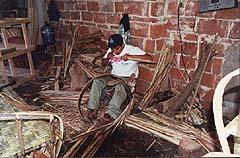
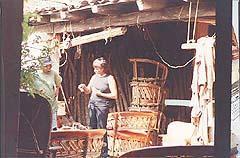
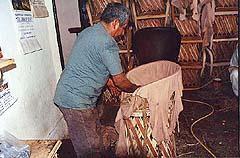
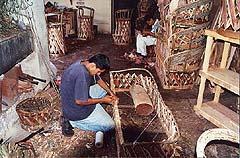
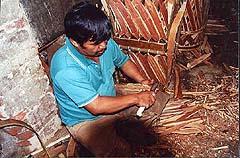

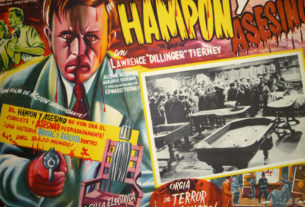
We were in Zacoalco de Torres in February, great little town
Thank you for sharing this history.
Thank you for learning and publishing this information. I purchased one of the chairs from an Antiques store. The individual who sold me this chair was able to provide a little historical information including that the chair was originally purchased some time in the 1920’s. It is in a condition that might require some love, but it can still be sat in and feels sturdy.
I had planned on fixing up the chair when I first bought it, but sadly I wasn’t able to get around to it and am going to look to pass it on.
Enjoyed your Equipale chair article we have a small Villa in Boca de Tomatlan (villalasirena.net) and bought 4 chairs direct from the factory – trying to dig thru records to find the manufacturer. We are in the process of revising our website with a Blog page. Would like to make equipale chairs a topic. Is there a way to use Wendy’s article? We would certainly acknowledge her work as well as provide info re: mexconnect.com
Thanks – Jerry
Response sent via email, TB. (editor)